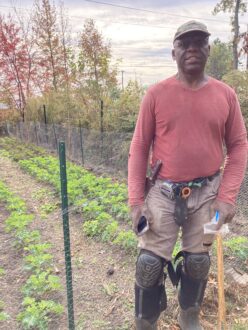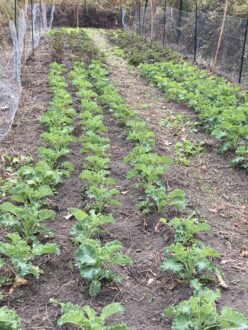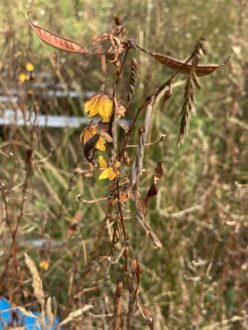SANDSTON, Virginia – Patches of partridge pea (Chamaecrista fasciculata) dot Patrick Johnson’s permaculture farm, still holding on to their yellow summer flowers while setting pods to drop seed in the coming colder temperatures.
Johnson is excited to see the native plant growing wild on his Airport Food Forest Farm; he believes the legume will make a good cover crop for small farmers interested in the practice, but are hampered by high establishment costs of non-native counterparts. He’s received a Southern Sustainable Agriculture Research and Education (SSARE) Producer Grant to test how well partridge pea serves that purpose in small-scale vegetable production.

“Native cover crops are easier to establish than their non-native counter parts and promote the presence of less pests and diseases and compete less with the main crop for soil resources like moisture,” said Johnson.
Like other cover crops, native species also carry a myriad of other benefits, such as reducing loss of topsoil, attracting beneficial insects, reducing soil erosion, adding soil biomass, and feeding soil microorganisms. In the case of partridge pea, the legume has the capacity to fix nitrogen, attract pollinators, and self-seed under the right soil conditions. Additionally, partridge pea is a pioneer species, meaning that it’s one of the first plants to establish itself in a disturbed environment to help ecosystem restoration.
In the Southern SARE Producer Grant project, Johnson is evaluating partridge pea in two phases: To characterize and document the plant’s wild growth habit, along with the ideal seeding rate; and to compare partridge pea with common commercial varieties (iron clay pea and cow pea) as a spring cover crop in kale and turnip production. The trials are taking place between his 400 square foot test plot and a trial plot at a fellow farmer’s operation, comparing cash crop yields based on soil type, cover crop biomass, and nitrogen content.

Preliminary data has suggested that the Cherokee National Forest partridge pea variety, the variety that grows wild on Johnson’s farm, performs well, germinating at the same time as cowpea and accumulating just as much biomass as cowpea. He’s measured 1.6 percent organic matter in his test plot using partridge pea as a cover crop.
Johnson’s project ends in 2024. For small farmers who are interested in partridge pea as a cover crop, he suggests seeking out the native variety that grows wild in their area and collect the seed, due to the cost of sourcing the seed.
“Local ecotypes are more tolerant of environmental conditions and are more locally adapted,” said Johnson, “making such native wild species a viable option for small farmers.” The literature indicates that local ecotypes make good garden plants, but some species can become invasive and overcrowd other desirable species.
